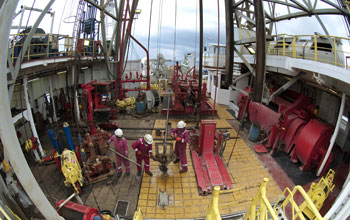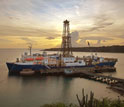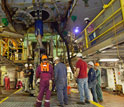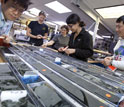News Release 12-154
Brazil Joins International Marine Research Effort
Newest nation to participate in Integrated Ocean Drilling Program

Scientists and engineers at work on the rig floor aboard the drill ship JOIDES Resolution.
August 21, 2012
This material is available primarily for archival purposes. Telephone numbers or other contact information may be out of date; please see current contact information at media contacts.
Brazil recently joined an international marine research effort to document environmental change by monitoring and sampling the unseen world beneath the sea floor.
The country's inclusion made it the newest of 26 member countries in the Integrated Ocean Drilling Program (IODP).
IODP scientists conduct research aboard specialized scientific drilling vessels to advance understanding of the Earth through drilling, coring, monitoring and documenting Earth processes and effects, solid Earth cycles, the subsurface biosphere, and geodynamics.
"We welcome the addition of Brazil's scientists and engineers to IODP at a time when the world needs the knowledge of its researchers," says Rodey Batiza of the U.S. National Science Foundation's Division of Ocean Sciences.
NSF manages the program along with Japan's Ministry of Education, Culture, Sports, Science and Technology.
The first IODP expedition with Brazilian researchers will begin in about six weeks off the coast of Costa Rica. Scientists plan to learn more about the processes that trigger large earthquakes.
The research will take place aboard the drill ship JOIDES Resolution as part of the Costa Rica Seismogenesis Project. Geoscientists will investigate an erosional subduction zone--a zone where Earth's crust is returning to the mantle at an eroding undersea trench.
It's the only known seismogenic zone at an erosional trench that's not too deep for current scientific drilling capabilities. Expedition scientists will work to understand how "unstable slip" is triggered in this zone.
Brazil's membership in IODP will enable recipients of grants through Brazil's "Science Without Frontiers" program to use IODP scientific facilities for their studies. In addition, an organization in Brazil known as Coordination for Improvement of Higher Education Personnel will host IODP's Brazil offices.
According to Batiza, Brazil's participation in IODP will allow Brazilian scientists to work with other international scientists on common problems at the same time--and give U.S. geoscientists, as well as those from other countries, the opportunity to learn from Brazilian researchers.
"Brazil's participation brings new opportunities not only for that country," says Batiza, "but for the global community."
"The most important part of this far-reaching marine geosciences program," he says, "is the first word in its name: integrated. We're all working together to explore the Earth under the sea."
Additional support comes from the European Consortium for Ocean Research Drilling, the Australia-New Zealand IODP Consortium, India's Ministry of Earth Sciences, the People's Republic of China's Ministry of Science and Technology and the Korea Institute of Geoscience and Mineral Resources.
The JOIDES Resolution is a scientific research vessel managed by the U.S. Implementing Organization (USIO) of IODP. Texas A&M University, Lamont-Doherty Earth Observatory of Columbia University, and the Consortium for Ocean Leadership comprise the USIO.
-NSF-
-
The drill ship JOIDES Resolution returning from an expedition to study the sea floor.
Credit and Larger Version -
Beneath the rig floor: The area is a beehive of activity during an expedition.
Credit and Larger Version -
Researchers conduct a geochemical analysis of the water in ocean-floor sediments.
Credit and Larger Version -
Geologists sample a sediment core brought up from beneath the bottom of the sea.
Credit and Larger Version
Media Contacts
Cheryl Dybas, NSF, (703) 292-7734, email: cdybas@nsf.gov
Related Websites
Integrated Ocean Drilling Program: Exploring the Earth Under the Sea: http://www.iodp.org
The U.S. National Science Foundation propels the nation forward by advancing fundamental research in all fields of science and engineering. NSF supports research and people by providing facilities, instruments and funding to support their ingenuity and sustain the U.S. as a global leader in research and innovation. With a fiscal year 2023 budget of $9.5 billion, NSF funds reach all 50 states through grants to nearly 2,000 colleges, universities and institutions. Each year, NSF receives more than 40,000 competitive proposals and makes about 11,000 new awards. Those awards include support for cooperative research with industry, Arctic and Antarctic research and operations, and U.S. participation in international scientific efforts.
Connect with us online
NSF website: nsf.gov
NSF News: nsf.gov/news
For News Media: nsf.gov/news/newsroom
Statistics: nsf.gov/statistics/
Awards database: nsf.gov/awardsearch/
Follow us on social
Twitter: twitter.com/NSF
Facebook: facebook.com/US.NSF
Instagram: instagram.com/nsfgov




